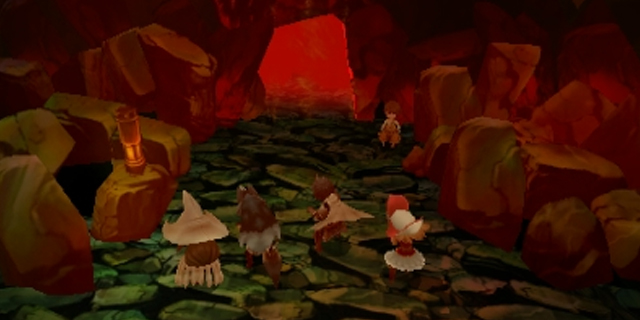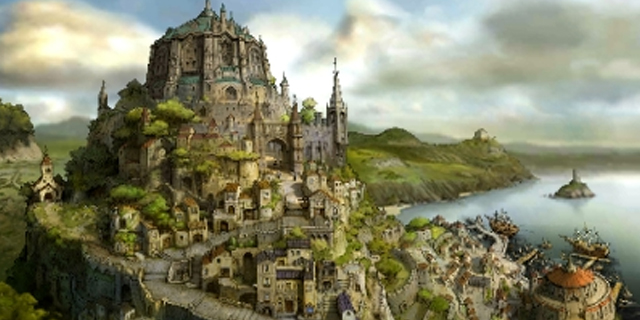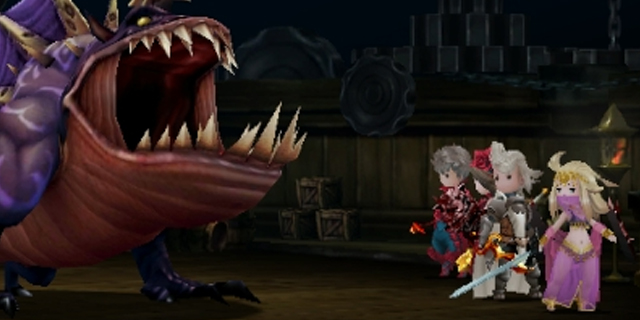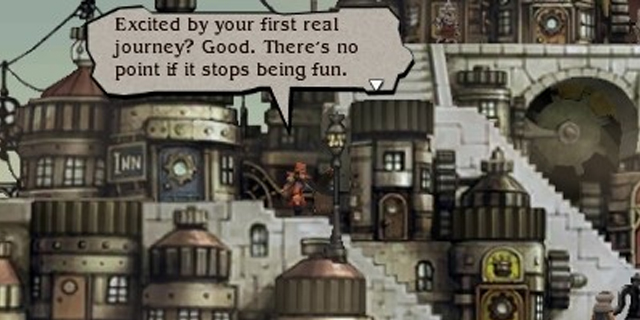
Bravely Default is often a contradiction. Obscure though its terminology may be, the game’s title indicates a bold step backward, and the gameplay itself follows just that philosophy. That said, the moments when it bucks tradition and even crushes it are what define the experience, for better or worse. (Usually better.)
The game is a spiritual sequel of sorts to a DS title, Final Fantasy: The 4 Heroes of Light, without the Final Fantasy branding but possibly bearing even more of the series’ hallmarks. The game’s job system, story structure and battle mechanics are most reminiscent of Final Fantasy V and IX, and the Akihiko Yoshida aesthetic will remind you of Final Fantasy Tactics. With the main series seemingly too focused on progressing what the JRPG can be, Square Enix decided it had to work outside of the franchise to, well, bravely default to the things that made Final Fantasy work so well back when it worked so well.
In true JRPG fashion, you can manage all aspects of your characters’ equipment and skills, but they’re specific, defined people with static personalities following a story that’s out of your control. Each has a compelling narrative arc: Tiz has to rebuild his hometown after it’s completely destroyed, Agnes must activate crystals to restore order in the world, Edea fights back against her father’s misdeeds and Ringabel… well, let’s just say he’s peculiar. All characters can equip all jobs you’ve managed to unlock, but each leans toward certain stats. Agnes is your clear caster and Edea is your hard-hitting attacker, while Tiz is balanced and best-suited to adventure-related tasks. Ringabel is the most agile in the group, but he’s also a viable second mage, so how you craft his repertoire can really change how the game plays.

Along the way to completing your quest, you’ll pilot airships, aid townsfolk, navigate labyrinths and open lots and lots of chests. It’s clear that Bravely Default desperately wants you to remember the old days, because on a surface level it really pushes those aspects. Once you start to get deeper, though, its modern touches take center stage. The first thing you’ll notice is how painless it makes things if you want that. You can control most of the game and all of the battles solely with the D-pad, or automate your characters to keep doing the last thing you put in. You can adjust the random encounter rate on the fly, from double all the way down to none, and there’s no penalty for this other than missing out on battle experience. This makes turning in side quests and backtracking to other towns nice and painless, and you can get in the battles when you choose (except bosses, of course).
Along with this is the game’s SP system. At any time in a battle, you can hit Select to use one of three Sleep Points, allowing one character to take one action immediately. These points replenish with eight hours of putting the system in sleep mode, and while they seem to be designed for doing crazy combo damage, they’re most useful when you’re in a tight spot and need a healing item or spell. Much was made of the “pay for SP drinks” feature, but frankly it doesn’t come up that much, and if you can set your system aside for a day, you get the same thing. It’s never necessary. Don’t worry.

Battles also play with an action-shifting mechanic. You can choose to “brave” or “default” at any given point; using “brave” gets you an extra action now at the expense of the next turn, and “default” allows you to stockpile actions to use with “brave” later. Each character is generally at zero actions, and if you’re still below zero when the number’s replenished by one at the beginning of the turn, you’re stuck for a while. There’s no discernible penalty for being at negative actions at the end of the battle, so if you’re confident that four moves per character will take out all the enemies, you can use “brave” three times apiece and do just that. It makes most battles trivial, unfortunately, and makes you start thinking whether they’re worth your gaming time at all, but if you like the rest of JRPGs and just get bored with random grinding, this is certainly a way to get around it.
As much as it’s a classic title, there are so many features designed to get players carrying the game around. You can use StreetPass to send and receive special moves and use them like items in battles, and if you have powerful friends with different abilities, this can be quite cool. StreetPassing also increases the population of your town, giving you more workers to rebuild shops and thus more items to buy from the roving Adventurer in each area. The early healing items are great to unlock for purchase in dungeons, and if you stick with it and use sleep mode a lot, you can get some absurdly-powerful equipment. The third StreetPass function shares special bosses you can fight at any time, though most of these are super-powerful, post-game foes.

While it would normally be tough to find StreetPass partners in the West, Bravely Default does three smart things. You can exchange data with demo players, who may not have such strong moves to use but definitely help you build out your town. You can send daily “net friend invites,” automatic SpotPasses that function similarly. There are also a couple of constantly-updating friend-bots in the game, to allow you to at least experience that part of things if you’re totally isolated.
The most important part about Bravely Default is that its world is a place where you really want to spend dozens of hours. The Yoshida art style with the system’s 3D effects make for something that feels fresh and new, and the soundtrack fits right in with its somewhat-subdued mysticism. You just want to sit and stare at some of the game’s towns, as each has its own distinct personality and visual trademark. The voice acting can be a bit stiff sometimes, and a few of the scenes are groan-worthy at best, but the main cast and important story scenes are done quite well.
Bravely Default is very much a new old Final Fantasy, in a way that will make series fans ecstatic but let newcomers in without all the intimidation of a long-running franchise’s lore. There are times when its innovations may go a bit too far in trivializing the whole exercise, and those who worry about that should come in prepared. Still, those who jump into its world will find a lot to enjoy.
Pros: Aesthetic is compelling, battle systems are thankfully streamlined
Cons: Innovations trivialize difficulty, lesser story elements are middling



















